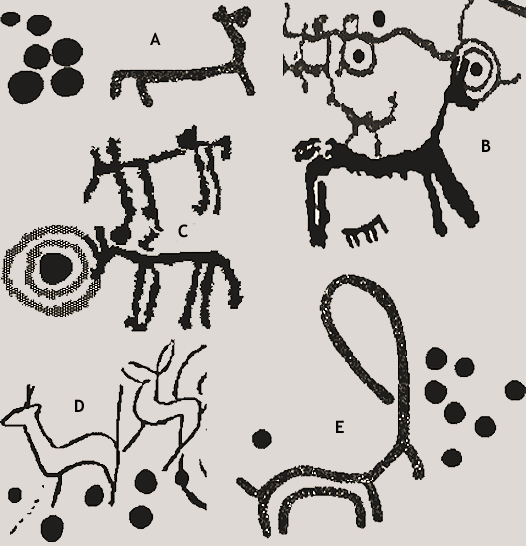 |
 |
TWYFELFONTEIN CUPULES |
2/8 |
| |
|
2.2: Analogies of Cupule-Animal Combinations (Page 1) |
It will be no surprise that, on a global scale, many instances have been reported where animal imagery was added to rocks already bearing cupules. For instance, I regard the animal engravings (mainly dating from the European Bronze and Iron Ages) at Carschenna, Switzerland (Figure 38C); Ballochmyle, Scotland (D); Galicia, Spain (E), and at some sites in Scandinavia (A) as secondary to existing cupule and cup-and-ring rocks, most of which possibly date from the European Neolithic (Van Hoek 2001). The addition of animal imagery could then represent an instance of re-sanctification or at least recognition of older but still sacred localities. In those cases, the importance and sacredness of the rock or site was still fully acknowledged, although the motives to execute animal imagery on cupule rocks may have been completely different.
Actually, as I already pointed out, it is a basic tenet in rock-art that images tend to accumulate at selected sites and also at specific rock panels. As in many cases cupules constitute the earliest (surviving) rock-art tradition in an area, it will be no surprise that especially such cupule sites often attracted subsequent artists who acknowledged the special properties of the rock or sites by adding imagery that expressed their beliefs. Taçon, Fullagar, Ouzman & Mulvaney describe several excellent examples from northern Australia where very ancient cupules are superimposed by other images. At the back of boulder KR1 at Jinmium, Northern Territory, they report a weathered peck-infill macropod (Figure 47.A), which is superimposed on top of several cupules (1997: 951). At boulder KR15 at Granilpi, 30 km NW of Jinmium, they noticed two red human-like figures painted over an upside-down purple emu which, in turn, lies over an unidentified peck-infill animal, with both the painted emu and the pecked animal lying over a row of cupules (Ibid. 959), thus representing no less than four layers of rock-art.
One would expect also the South African rock-engraving traditions, often closely related to the Namibian rock-art traditions, to have several sites where cupules are found together with animal imagery. Surprisingly however, there are only very few instances where animal engravings are associated with cupules and clear cases of superimposition, like those from Australia, are even more rare. This "absence" underlines the anomaly that Twyfelfontein is in this respect.
At Putsonderwater in the Orange River valley of South Africa, Fock & Fock (1989: 130, Tafel 142.3) mention and illustrate a domesticated (?) bovine that is associated with at least nine cupules (Figure 46.F), but the relation and/ or relative chronology is obscure. At Disselfontein, also in the Orange River valley, there are several isolated clusters of small cupules, said to represent the eggs of an ostrich nest (Fock & Fock 1989: Tafel 117.6). This may be an explanation for such clusters of cupules, but only one example (rather convincing, though), has been reported so far with an ostrich standing over such a "nest" (Figure 46.A). But here again there is no 100% certainty that the cupules are indeed contemporary. Notably, subsequent visitors to the site might have interpreted existing cupules as ostrich eggs (and may have added the ostrich for that reason).

Figure 38
On the other hand, in other areas cupules associated with animals have indeed been interpreted as eggs. For instance, turtle engravings on the Murujuga "Peninsula" of Western Australia are often found associated with aggregations of pecked cupules. Such clusters of cupules are suggested to "probably represent turtle eggs that were collected by the Aboriginal people during summer" (Vinnicombe 2002: 20).Notwithstanding these remarks, it is remarkable that ostrich eggs have not been depicted more often in southern African rock-art, in view of the enormous material and spiritual importance of ostrich eggs and eggshells for the indigenous peoples. Interestingly, the ubiquitous beads made out of ostrich eggshells are said to possibly explain the painted microdots in southern African rock-art (Dowson 1989: 84), but Dowson also postulates another interpretation for such painted microdots, as will be explained further on.
In Part 1 I already mentioned the site at Tshikongomoti in the north of South Africa, but at that site too, no direct relationship between the cupules and the animal imagery could be established. At a site west of Tshipise, also in the north of South Africa, there are two large engraved eland that have been placed on top of three cupules with still seven other cupules nearby. Some of these cupules occur in pairs as to resemble animal spoor. This confirms the idea that cupules and engraved animal spoor do seem to correlate in certain instances (Sven Ouzman 2001: pers. comm.). At both Tshipise and Tshikongomoti it seems that the cupules are older than the animal imagery.
Much further north, in the vast Sahara Desert, thousands of rock-art sites occur, many featuring animal imagery. Cupule rocks seem to be relatively scarce however, and moreover the recorded instances often involve depressions of dubious anthropic origin or cannot be regarded as authentic cupules (Huard & Leclant 1980b: 323). Again, clear cases of superimposition of cupules or by cupules are very rare.
Yet, it will be useful to compare a selection of cupule rocks from northern Africa with the Twyfelfontein cupules (see
Figure 39 for Saharan site-locations; further references to sites on this map will be given as follows: Site 39.XX). Surrounding the Ténéré Desert in the Central Sahara, one of the most desolate and inaccessible areas in the world, are three rugged mountain ranges: the Hoggar or Ahaggar Mountains to the NW (Site 39.15), the Aïr Mountains to the SW (Site 39.17) and the Tibesti Mountains to east (Site 39.19). Each area has an enormous amount of rock-art sites comprising much differing styles and art periods.
Cupule rocks are relatively scarce also in this vast area. Ulrich and Brigitte Hallier (Hallier 1990, Hallier & Hallier 1992) describe and lavishly illustrate more than 150 new rock-art sites in the Enneris of the Djado Plateau (Site 39.18), but no rock with only cupules has been recorded as yet. The art from the Djado Plateau also features pecked Round Head rock-art imagery, which is probably much older than the Bubalus Period (Hallier 1997). Hallier now is of the opinion that many cupules from the Djado belong to the Round Head Period or are possibly even older (Ulrich Hallier 2002: pers. comm.). Again, animal imagery is predominant in their study area. Only a few of the panels with iconic imagery feature one or two cupules, often of uncertain status (e.g. sites F-X, F-1 and F-XVII). At site F-XXIV, Hallier (1990: 86) reports a panel with some animal engravings together with two authentic cupules, but a relation between the two elements is obscure, especially as the relative ages are unknown.
Further north, at Wadi Hassan, two neighbouring rock-art sites in the Aramat District of SW Libya (combined in Site 11 in
Figure 39), featuring interesting combinations and/or superimpositions of cupules and animals, were discovered by Birgitte and Ulrich Hallier (2000). Importantly, no rocks with only cupules were recorded. The entrance of a shallow cave (about 4m deep and too low to store cattle, although the engraved animals all seem to "walk into the shelter" - Ulrich Hallier 2001: pers. comm.) is formed by a long wall that is covered with animal engravings, apparently unplanned cupules and some geometric designs. It seems that the geometric nested curves are earlier than the cupules, as there clearly are two cases of cupules superimposing such geometric designs (marked 1 and 2 in
Figure 40). As no other true instances of palimpsest can be recognised, it seems justifiable to suggest that the animal engravings are later than the cupules. Just possibly the execution of the larger animal avoided cupule 3 and incidentally (?) incorporated four other cupules.
→
A Survey into the Relationship between
Animal-Engravings & Cupules
→
The Rock Art of Twyfelfontein
→
The Rock Art of Namibia
→
The African Rock Art Archive
→
Bradshaw Foundation
Like us on Facebook & Follow us on Twitter to receive news & updates:










